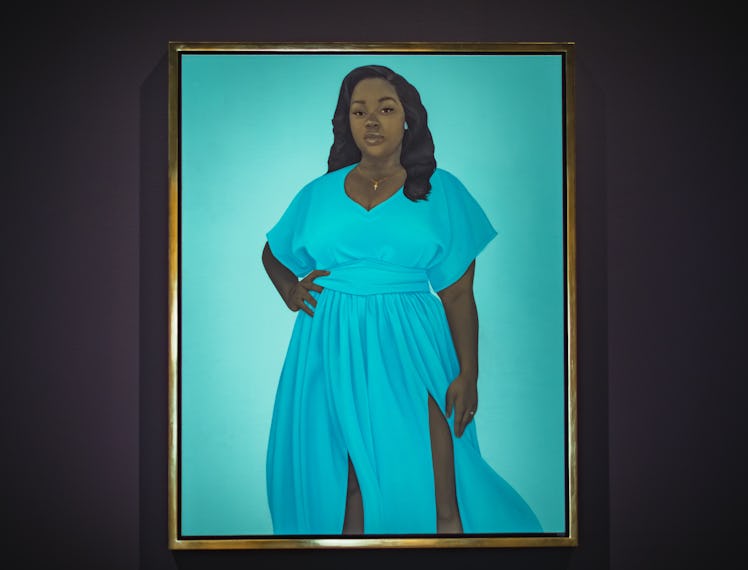Breonna Taylor’s Spirit Comes to Life in a New Art Exhibition

Within little over a week, white police officers have shot and killed 20-year-old Daunte Wright, a Black man, and 13-year-old Adam Toledo, who was Latino—sparking yet another wave of protests across the U.S. Between all that and the ongoing trial of Derek Chauvin, who is charged with the murder of George Floyd, the curator Allison Glenn decided she needed to take the week off.
Ever since last fall, for Glenn, work has meant sitting in the very thing that she would like to avoid thinking about: the senseless police killings of Black Americans. “Promise, Witness, Remembrance,” the new exhibition she curated, focuses on one in particular: the late 26-year-old EMT Breonna Taylor. On March 13, 2020, three police officers shot Taylor eight times under a no-knock warrant. At the time, Taylor was asleep in her home, not too far from the Speed Art Museum in Louisville, Kentucky, where the show is now on display.
“I want [people] to say her name,” Taylor’s mother, Tamika Palmer, said last June. And people did—so many times, and eventually so casually, that “arrest the cops who killed Breonna Taylor” became first a catchphrase, and then a meme. “Promise, Witness, Remembrance” is a return to what Palmer—and Kimberlé Crenshaw, who started the Say Her Name campaign in 2014—intended. It’s a show of recognition that Taylor wasn’t a statistic, but a person: a daughter, a sister, a partner, and an essential worker. Glenn had never met Taylor, nor visited Louisville, so she assembled a national advisory panel and worked with a local steering committee organized by the Speed’s Toya Northington. The end result, Palmer has said, is “filled with [her daughter’s] spirit.”
Hank Willis Thomas, 15,433 (2020), 2021, and 19,281 (2020), 2021.
The show’s centerpiece was a no-brainer: Amy Sherald’s portrait of Taylor, standing confidently in a turquoise dress and the engagement ring she never got to receive. (It appeared on the cover of Vanity Fair last September.) Glenn positioned it to be visible all throughout the show, which is divided into three sections. The first features another careful choice of installation. Flanking one of the main doorways are two towering flags by Hank Willis Thomas, which are technically simply patterned with stars. But the number of stars is extremely—and harrowingly—specific. The titles of 15,433 and 19,281 represent the number of people murdered by gun violence in the U.S. in 2019 and 2020, respectively.
The annual, ongoing Fallen Stars series is just one of the ways Thomas has recognized the “unacknowledged victims” of gun violence: the loved ones who have been left to confront a lifetime of trauma and grief. Behind Floyd and his family, for example, is Darnella Frazier, who was 17 when she filmed the fateful video of Chauvin kneeling on Floyd’s neck for more than nine minutes. (To say her testimony at the Chauvin trial was devastating is an understatement.) Thomas, for one, hasn’t forgotten about Ramsey Orta. He was jailed on “bogus charges” for years in what many believe was retaliation for filming a police officer using an illegal chokehold on his late friend, Eric Garner.
Tyler Gerth, Untitled, June 11, 2020.
Such issues aren’t the full scope of Thomas’s work. The same goes for other artists featured, including heavyweights like Kerry James Marshall, Glenn Ligon, Rashid Johnson, Nick Cave, Theaster Gates, and Lorna Simpson. But they have come to define many of their lives—and, in one case, death. The photographer Tyler Gerth was shot and killed while taking protest photos like the one that now hangs on the Speed’s walls.
Last September, the former Louisville detective Brett Hankison was indicted for “wanton endangerment” of Taylor’s neighbors for firing his gun without a clear line of sight. The other two officers involved have yet to be charged at all. But even if they were, as well as found guilty, would that be justice? What does justice look like when we leave it up to a broken system, and lives are still forever lost?
Thomas isn’t sure, but he knows it’s something we all need to continue to explore.
“For some people, and maybe some outlets, this topic is trendy. And for a lot of the artists, and obviously the families affected, this is perpetual. This is permanent,” he said. “We don't want this to just be a passing phase. We're still just at the beginning of the diagnosis of issues like institutional racism. That's also part of the reason why we make the work: We want future generations to have the locus and to be connected and to understand that the struggle continues.”